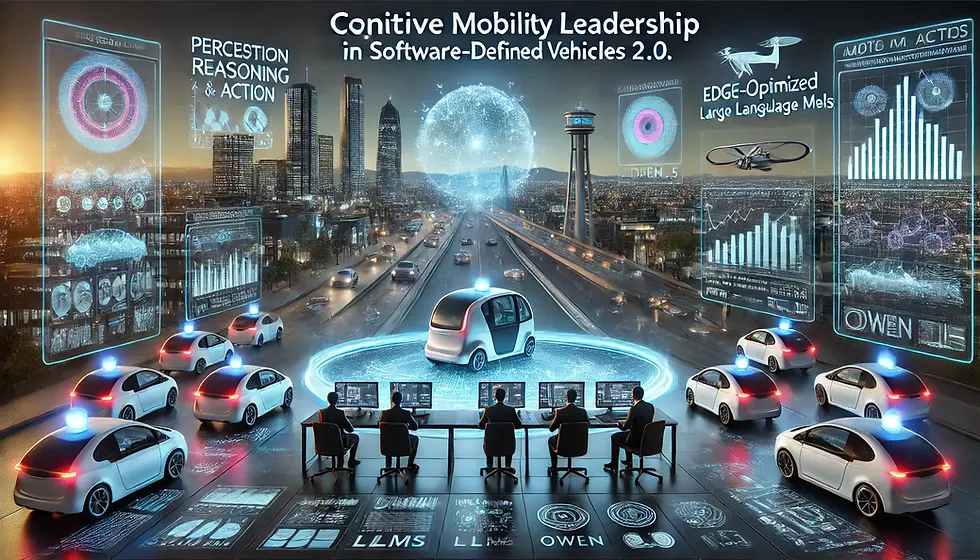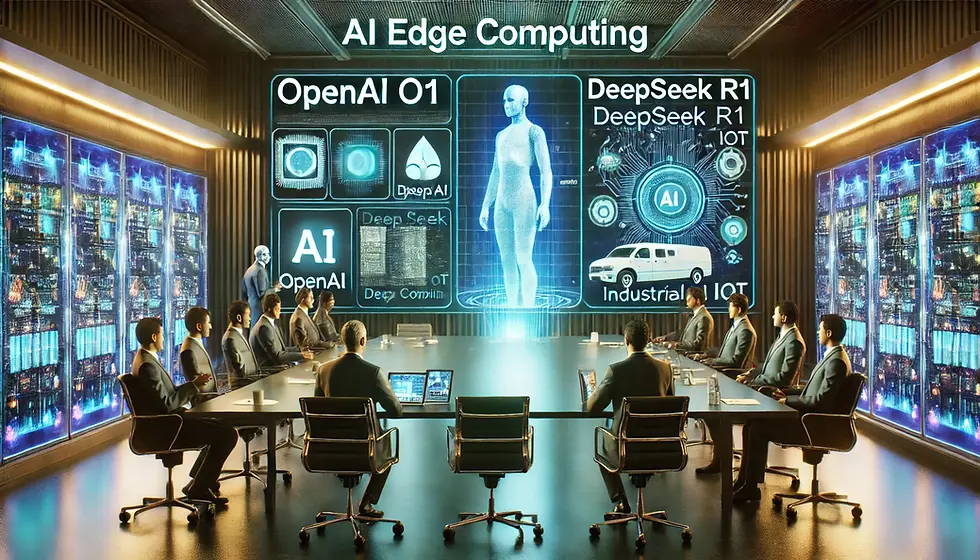Flying Cars Are Real: How eVTOLs and Physical AI Are Redefining the Future of Transportation
- Mahbubul Alam

- Apr 12
- 6 min read

Just a decade ago, flying cars were pure science fiction. Today, advances in electric propulsion and artificial intelligence have given rise to eVTOLs – electric vertical take-off and landing vehicles – essentially flying taxis poised to transform urban mobility. At the same time, Physical AI (AI integrated into physical machines like robots and autonomous vehicles) is enabling these breakthroughs, allowing vehicles to operate autonomously. Together, eVTOLs and physical AI are redefining the future of transportation, ushering in an era of urban air mobility and smart, autonomous systems.
The eVTOL market is projected to grow explosively. Valued under $1 billion in 2024, it’s forecast to reach around $4.7 billion by 2030 and $17 billion by 2035 (eVTOL Aircraft Market: Size, Share, Trends, and Growth Analysis (2024–2035)). Analysts also predict roughly 8,000–12,000 eVTOLs in service globally by 2035 (OPINION: Winning in the advanced air mobility market - Aerospace America). This growth is fueled by advances in batteries, autonomous flight tech, and the demand for new urban transit solutions. Major airlines and rideshare companies are already partnering with eVTOL developers, anticipating a lucrative new mobility ecosystem in the skies.
eVTOLs: From Concept to Urban Air Mobility Reality
For the first time, viable electric air taxis are taking to the skies. eVTOL aircraft take off and land vertically using all-electric power, eliminating the need for runways. They promise to bypass ground traffic and offer fast urban air mobility for commutes, airport transfers, and emergency flights, all with zero emissions at point of use.
Key eVTOL Innovators (USA, China, Europe):
Company | Region (Country) | Notable eVTOL Model | Status (Target Launch) |
Joby Aviation | USA | 5-seat tilt-rotor eVTOL | FAA certification in progress; targeting 2025 service (eVTOL Aircraft Market: Size, Share, Trends, and Growth Analysis (2024–2035)). |
Archer Aviation | USA | 5-seat “Midnight” eVTOL | United Airlines partnership; aiming for 2025 launch (eVTOL Aircraft Market: Size, Share, Trends, and Growth Analysis (2024–2035)). |
EHang | China | 2-seat autonomous EH216 | World's first unmanned eVTOL type certified in 2023 (EHang EH216-S passenger-carrying UAV system obtains standard airworthiness certificate from CAAC - Vertical Mag); launching initial air taxi services in China. |
Volocopter | Germany | 2-seat VoloCity multicopter | Working with EASA on certification; trial flights in Paris, targeting 2025 launch ([Plans to fly air taxis with passengers during Paris Olympics scrapped |

In the U.S., companies like Joby and Archer have conducted hundreds of test flights and are working with the FAA, eyeing a commercial debut by 2025. In China, EHang achieved a world-first by certifying its autonomous eVTOL in 2023 (EHang EH216-S passenger-carrying UAV system obtains standard airworthiness certificate from CAAC - Vertical Mag), allowing pilotless air taxis to start limited services. Europe’s Volocopter and Lilium, backed by strong engineering and regulatory support from EASA, are not far behind – Volocopter even planned public demo flights at the 2024 Paris Olympics to showcase flying taxis (Plans to fly air taxis with passengers during Paris Olympics scrapped | Reuters).
Key Takeaways (eVTOLs):
Flying cars are becoming real: eVTOL prototypes are quickly moving toward commercial electric air taxi services, with pilot routes expected by the mid-2020s.
Global push: The U.S., China, and Europe each have leading players (Joby, EHang, Volocopter, etc.) driving a worldwide race to launch urban air mobility networks.
Massive growth ahead: The eVTOL sector could reach $5B+ by 2030 and ~$17B by 2035 (eVTOL Aircraft Market: Size, Share, Trends, and Growth Analysis (2024–2035)), accompanied by thousands of autonomous flying vehicles in operation (OPINION: Winning in the advanced air mobility market - Aerospace America).
Physical AI: Intelligent Machines Powering Autonomous Vehicles
Physical AI refers to AI embodied in machines that interact with the physical world. It is the “brain” inside robots, drones, and autonomous vehicles – enabling them to perceive surroundings and make real-time decisions without human control. In transportation, physical AI makes autonomous flying vehicles and self-driving cars possible by combining advanced sensors with intelligent control software.
Key Takeaways (Physical AI):
AI meets the real world: Physical AI embeds intelligence in robots and vehicles, allowing machines to act autonomously in everyday environments.
Cross-industry impact: From delivery drones to medical robots and factory automation, physical AI is driving efficiency and new services across logistics, healthcare, and manufacturing.
Enabling autonomy: The autonomous capabilities of eVTOL flying cars (and self-driving cars) are a direct result of advances in physical AI, intelligent systems are effectively the pilots of this new transport era.
Physical AI in Action – Use Cases:
Logistics & Delivery: AI-powered robots and drones are revolutionizing logistics. Over 800,000 commercial drone deliveries in 2023 (Consumer views of drone delivery: How soon can you get here?) illustrate how autonomous drones are speeding up supply chains.
Healthcare: Drones guided by AI deliver vaccines and blood to remote areas (10,000+ medical items via drone in India (Drones are transforming healthcare access in parts of India | World Economic Forum)), cutting critical delivery times. In hospitals, AI-driven robotic systems assist in surgeries and routine tasks.
Smart Factories: In manufacturing, smart factory robots use AI to adapt to different tasks and inspect quality in real time, working safely alongside humans to boost productivity.
Notably, the same advances in physical AI that power these use cases are enabling eVTOLs. An autonomous air taxi, for example, relies on AI for obstacle avoidance, routing, and flight stabilization – effectively a flying robot. As physical AI technology improves, we’ll see more capable autonomous flying vehicles and smarter infrastructure supporting them.
The Global Race: USA, China, and Europe Drive eVTOL Innovation
A global race is underway to dominate the eVTOL and urban air mobility market, with the United States, China, and Europe in the lead:
United States: Well-funded U.S. startups (Joby, Archer, etc.) with FAA support plan to launch the first eVTOL air taxi services in 2025.
China: China, backed by government support, saw EHang secure the world’s first eVTOL type certification in 2023 (EHang EH216-S passenger-carrying UAV system obtains standard airworthiness certificate from CAAC - Vertical Mag) giving it a head-start in rolling out air taxi services.
Europe: Europe’s Volocopter and Lilium are working with EASA to certify eVTOLs, emphasizing safety. Volocopter even conducted a test flight in Paris and is targeting a 2025 launch (Plans to fly air taxis with passengers during Paris Olympics scrapped | Reuters).

Key Takeaways (Global Race):
Neck-and-neck competition: The U.S., China, and Europe are all vying to be first in deploying eVTOL air taxi networks, spurring rapid innovation and investment in each region.
First milestones achieved: China’s EHang secured the first eVTOL type certification (EHang EH216-S passenger-carrying UAV system obtains standard airworthiness certificate from CAAC - Vertical Mag), while U.S. and European players are close behind with planned launches by 2025–2026.
Race benefits: This global competition is prompting regulators to establish standards and cities to prepare infrastructure, effectively fast-tracking the urban air mobility revolution.
What’s Next: Infrastructure and Regulatory Readiness
Technology alone won’t make flying cars commonplace, stakeholders must build the ecosystem around eVTOLs.
Key Takeaways (Next Steps):
Vertiports & Charging: Build networks of eVTOL landing pads and ultra-fast charging stations like megawatt charging systems in cities to enable convenient air taxi routes.
Air Traffic Management: Deploy smart traffic-control systems so autonomous flying vehicles can safely share urban skies.
Regulation & Public Trust: Finalize eVTOL certification standards and operating rules, and engage communities early to address noise and safety concerns.

Conclusion: A New Era of Transportation Takes Flight
eVTOL flying cars and AI-driven vehicles are moving from fantasy to reality, promising faster commutes, less congestion, and on-demand air travel. But achieving this future requires more than technology, it demands supportive policies, new infrastructure, and public trust. Encouragingly, the pieces are coming together: companies, governments, and investors are aligning to overcome hurdles. With continued collaboration and commitment to safety and sustainability, the sky can truly become a new highway for transportation in the next decade.
Are We Ready for Urban Air Mobility?
As flying cars and autonomous vehicles move from science fiction to flight-ready prototypes, a new question arises — are we and our societies truly ready for this shift in transportation? The technology is accelerating, but adoption depends just as much on public trust, regulatory readiness, and urban infrastructure.
Will we trust autonomous flying taxis enough to board them for daily commutes or emergency travel?
How will cities adapt, from air traffic systems to vertiports, and how fast can they evolve?
Can communities embrace this new layer of urban mobility without concerns over safety, noise, or equity?
Which global region will balance innovation and societal acceptance fastest, the U.S., China, Europe, or emerging markets?
The future of mobility is already lifting off — but it's not just about the vehicles. It's about us.
What’s your take? Are we prepared for this leap into the skies?
#UrbanAirMobility #FlyingCars #eVTOL #FutureOfTransportation #AutonomousVehicles #PhysicalAI #SmartCities #AdvancedAirMobility #MobilityInnovation #TechForGood #CleanMobility #AIAutomation #MobilityEcosystem #SmartInfrastructure #NextGenTransport #TransportationInnovation #AIinAviation #FutureCities #ZeroEmissionMobility #SustainableTransport #MobilityTech #UrbanMobility #Transportation2030 #LinkedInPulse #TechLeadership #SmartAvatar



Comments